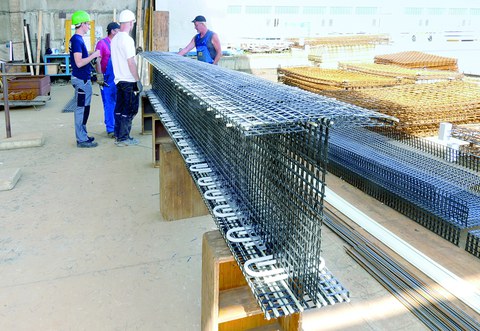TRC beam for C3-B2
Table of contents
Project data
| Titel | Title Konzeption eines Textilbetonträgers für das Vorhaben C3-B2 | Design of a textile reinforced beam for the project C3-B2 Förderer | Funding Institut für Massivbau, TU Dresden Leiter | Project manager Prof. Dr.-Ing. Dr.-Ing. E.h. Manfred Curbach Zeitraum | Period 04.2016–11.2016 Bearbeiter | Contributors Dipl.-Ing. Alexander Schumann, Dr.-Ing. Harald Michler Projektpartner | Project partners Institut für Baustoffe, TU Dresden | Betonwerk Oschatz GmbH |
Report in the year book
A new way of construction?

Preparation of the reinforcing cage
Within the C³-project C3-B2, new concrete mixtures for carbon reinforced concrete were developed. By the project’s completion, a large component test was planned for a selected concrete mix to prove the practical suitability of this mix. The aim was to produce both a standard reinforced concrete beam made of normal strength concrete and a comparable beam made of carbon reinforced concrete. So, a direct comparison between the two materials should be possible. For the conceptual design and the structural calculations, the project manager, the Institute of Construction Materials of the TU Dresden, requested the support of the Institute of Concrete Structures.
One of the goals of the C³-project as a whole is resource-saving construction. For this reason, the carbon concrete beam was designed to be as slim as possible. In relation to the given, standardized and non-optimized steel reinforced concrete cross section, the beam made of carbon reinforced concrete was optimized. By using a new developed concrete with a strength class of C50/60 instead of the strength of C30/40 used in the steel reinforced concrete beam, the thickness of the compression zone was reduced from 20 cm to 7 cm. Additionally, the web’s width could be reduced from 20 cm to 10 cm. Moreover, it was possible to save concrete in the tensile zone, because the concrete cover is only needed to ensure the bond between reinforcement and matrix, and it’s no longer needed for corrosion prevention.
Carbon textiles and bars made of alkali-resistant (AR) glass fibers were used as reinforcement. The AR glass bars had to be used because carbon fiber bars were not available in the desired configuration at the time. The bars had to carry the tensile forces that resulted from bending and from handling, and they also had to connect the beam’s web and flange. The carbon textile layers were used as surface and shear reinforcement. The final result was a steel-free beam emerged, whose sectional area had been reduced to half of that of the reinforced concrete beam. In addition, the amount of AR glass and carbon reinforcement – all together only 55 kg – was reduced considerably compared with the 236 kg necessary steel reinforcement in the reinforced concrete beam.
All beams were produced in the concrete plant Betonwerk Oschatz. The component testing to confirm the predicted load bearing behaviour for both the steel reinforced and textile reinforced concrete beams was successfully accomplished in the Otto-Mohr-Laboratory.
